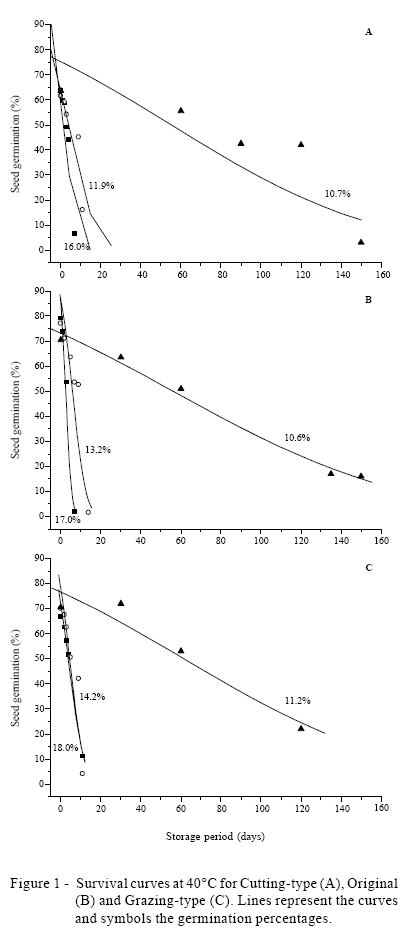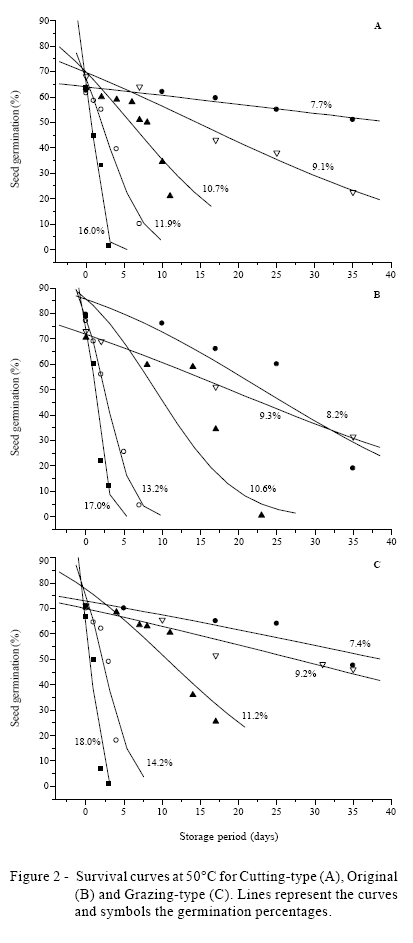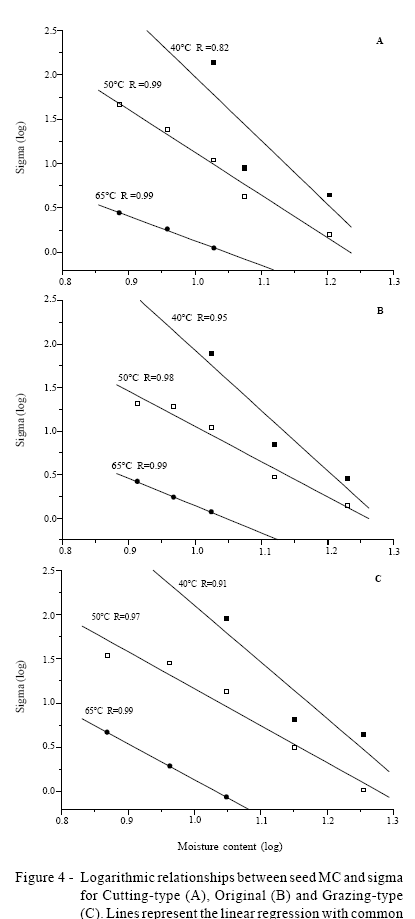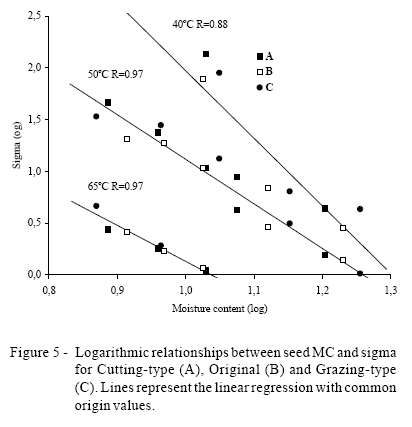Abstracts
In order to allow using seeds from three interspecific elephant grass ×pearl millet hybrids (Original, Cutting and Grazing-types) to set pasture fields, it became necessary to analyze their performances in relation to storage conditions and controlled deterioration. Five moisture content levels and three storage temperatures (40, 50 and 65°C) have been tested for each hybrid. Seed sub samples for each moisture content and storage temperature combination were sealed in laminated aluminum foil packages and stored at those temperatures until complete survival curves have been obtained. The recurrent selection increased seed initial quality (Ki) for grazing-type population (lower and more tillered plants); however inverse results were observed for cutting-type population (higher and less tillered plants). Viability equation constants estimated for Cutting-type, Original and Grazing-type hybrids are: K E = 8.417, 7.735 and 8.285; Cw = 5.037, 4.658 and 4.522; C H = 0.02309, 0.01969 and 0.03655; C Q = 0.000436; 0.000403 and 0.000300, respectively. The viability equation constants for the hybrids are K E = 8.033; Cw = 4.662; C H = 0.02544; C Q = 0.000386. Through the equations, it is feasible to estimate the germination percentage of a seed lot after different storage conditions.
Pennisetum purpureum × P. glaucum; recurrent selection; viability equation
Para facilitar o uso de sementes de três híbridos interespecíficos de capim-elefante × milheto (Original, Corte e Pastoreio) para a formação de pastagens, tornou-se necessário analisar o seu comportamento em diversas condições de armazenamento e deterioração controlada. Foram testados para cada híbrido cinco graus de umidade e três temperaturas (40, 50 e 65°C). Em cada combinação de umidade e temperatura, as sementes foram embaladas em papel-alumínio multifoliado e semeadas periodicamente, permanecendo nas estufas até a obtenção de curvas completas de deterioração. A seleção recorrente aumentou a qualidade inicial (Ki) na população de pastoreio (plantas mais baixas e mais perfilhadas) e o inverso ocorreu na população de corte (plantas mais altas e menos perfilhadas). As constantes obtidas para os híbridos Corte, Paraíso e Pastoreio são: K E = 8,417; 7,735 e 8,285; Cw = 5,037; 4,658 e 4,522; C H = 0,02309; 0,01969 e 0,03655; C Q = 0,000436; 0,000403 e 0,000300, respectivamente. Foi possível obter uma equação única de viabilidade para os híbridos, com constantes iguais a: K E = 8,033; Cw = 4,662; C H = 0,02544; C Q = 0,000386. Essa equação possibilita estimar a porcentagem de germinação de um lote de sementes após o armazenamento em diversas condições de temperatura e umidade.
equação de viabilidade; Pennisetum purpureum × P. glaucum; seleção recorrente
FORAGE CROPS
Seed controlled deterioration of three interspecific elephant grass × pearl millet hybrids
Deterioração controlada de sementes de três híbridos interespecíficos de capim-elefante × milheto
Marina PozitanoI; Roberto UsbertiII
IFaculdade de Engenharia Agrícola, UNICAMP, Campinas, Brasil
IICoordenadoria de Defesa Agropecuária, Caixa Postal 960, CEP: 13073-001, Campinas, SP, Brasil
ABSTRACT
In order to allow using seeds from three interspecific elephant grass ×pearl millet hybrids (Original, Cutting and Grazing-types) to set pasture fields, it became necessary to analyze their performances in relation to storage conditions and controlled deterioration. Five moisture content levels and three storage temperatures (40, 50 and 65°C) have been tested for each hybrid. Seed sub samples for each moisture content and storage temperature combination were sealed in laminated aluminum foil packages and stored at those temperatures until complete survival curves have been obtained. The recurrent selection increased seed initial quality (Ki) for grazing-type population (lower and more tillered plants); however inverse results were observed for cutting-type population (higher and less tillered plants). Viability equation constants estimated for Cutting-type, Original and Grazing-type hybrids are: KE = 8.417, 7.735 and 8.285; Cw = 5.037, 4.658 and 4.522; CH = 0.02309, 0.01969 and 0.03655; CQ = 0.000436; 0.000403 and 0.000300, respectively. The viability equation constants for the hybrids are KE = 8.033; Cw = 4.662; CH = 0.02544; CQ = 0.000386. Through the equations, it is feasible to estimate the germination percentage of a seed lot after different storage conditions.
Key Words:Pennisetum purpureum × P. glaucum, recurrent selection, viability equation
RESUMO
Para facilitar o uso de sementes de três híbridos interespecíficos de capim-elefante × milheto (Original, Corte e Pastoreio) para a formação de pastagens, tornou-se necessário analisar o seu comportamento em diversas condições de armazenamento e deterioração controlada. Foram testados para cada híbrido cinco graus de umidade e três temperaturas (40, 50 e 65°C). Em cada combinação de umidade e temperatura, as sementes foram embaladas em papel-alumínio multifoliado e semeadas periodicamente, permanecendo nas estufas até a obtenção de curvas completas de deterioração. A seleção recorrente aumentou a qualidade inicial (Ki) na população de pastoreio (plantas mais baixas e mais perfilhadas) e o inverso ocorreu na população de corte (plantas mais altas e menos perfilhadas). As constantes obtidas para os híbridos Corte, Paraíso e Pastoreio são: KE = 8,417; 7,735 e 8,285; Cw = 5,037; 4,658 e 4,522; CH = 0,02309; 0,01969 e 0,03655; CQ = 0,000436; 0,000403 e 0,000300, respectivamente. Foi possível obter uma equação única de viabilidade para os híbridos, com constantes iguais a: KE = 8,033; Cw = 4,662; CH = 0,02544; CQ = 0,000386. Essa equação possibilita estimar a porcentagem de germinação de um lote de sementes após o armazenamento em diversas condições de temperatura e umidade.
Palavras-chave: equação de viabilidade, Pennisetum purpureum × P. glaucum, seleção recorrente
INTRODUCTION
Elephant grass (P. purpureum) is a tropical forage grass species with high potential for dry matter production, which has been used either for direct animal grazing or for feeding complementation during the drought period. Its productive potential, associated to other desirable forage traits, such as palatability, vigor and persistence, have been stimulating the cultivation and the genetic improvement of the species (Souza Sobrinho et al., 2005).
Elephant grass has been thoroughly used in Brazil and contributes to milk production increase; however there have been few improved cultivars available (Pereira et al., 2001). Most elephant grass cultivars do not produce viable seeds, thus hindering its more intense use to set pasture fields. On the other hand, pearl millet (P. glaucum) presents high production of viable seeds, but with low potential for forage production.
An interspecific Pennisetum purpureum (elephant grass) × P. glaucum (pearl millet) hybrid has been developed in 1980 at the University of Georgia, USA, aiming to obtain rusticity and high forage production of elephant grass and high production of pure pearl millet seeds; in 1995, the hybrid was introduced in Brazil with the name of Paradise, from now on called Original (Schank et al., 1996).
However, this hybrid revealed low phenotypic uniformity (± 50.0%) as well as low pure seed production (5-10.0%). Improved populations were obtained through a recurrent selection scheme during three consecutive seasons from that hybrid, resulting in two new interspecific hybrids (Cutting and Grazing-types), showing high phenotypic uniformity in the field (≥80.0%) and good pure seed production (± 30.0%), making feasible the establishment of new pasture fields using these seeds (Usberti Jr. et al., 2005; Usberti et al., 2005; Reis et al., 2008).
Moisture content (MC) is considered the most important factor in seed longevity, along with the storage temperature (T). According to Harrington (1972), seed viability would be doubled to each 1% reduction in MC or to each a decrease of 5.6°C in T.
Ellis & Roberts (1980) proposed a reliable equation to estimate the changes in seed germination percentages during storage. The objectives of this research work were to analyze seed performance of the previously mentioned interspecific hybrids during storage under controlled deterioration, aiming to preserve the initial seed quality for a longer period of time as well as to define the viability equation constants for each hybrid.
MATERIAL AND METHODS
This experiment has been carried out during 18 months at the Post-Harvest Technology Laboratory, School of Agricultural Engineering, Campinas State University, Brazil. Seeds from the Original hybrid and the hybrids selected by recurrent selection (Cutting and Grazing-types) were used in this experiment. The weights of the samples were 1118.3 and 1056.9 g of seeds without purity for Cutting-type and Original and 775.7 g of pure seeds for Grazing-type, respectively.
Seed MC was adjusted at 25°C from initial values (± 10%), before experimental storage, either by rehydration above water (3 cm) in a closed recipient or by dehydration in desiccators with silica gel. After 3-5 days at 5°C for moisture homogenization, seed MC was estimated in 4 × 25 g pure-seed replicates using the high-constant temperature oven method (130-133°C, 2 hours) (ISTA, 2006).
Sub samples containing a minimum of 200 seeds for each hybrid were sealed in laminate aluminum foil packages, divided into blocks of 12 sub samples and subsequently stored in incubators maintained at 40, 50 and 65ºC (± 0.5) until complete survival curves have been achieved.
All seed samples showing MC lower than 3% were humidified above water at 25ºC for 2 days before testing in order to avoid the possibility of imbibition injury during rehydration (Ellis et al., 1988).
Germination tests were performed on 4 × 50 pure seed replicates, placed in plastic square boxes (11 × 11 cm) over a filter paper moistened with distilled water; afterwards, the replicates were kept in incubators under 20-30°C alternate-temperature regime (16 hours at 20°C and 8 hours at 30°C, with light). Seedling counts were performed at 3 and 7 days after seeding, according to procedures established by ISTA Rules for P. glaucum species (ISTA, 2006).
TZ viability tests were not performed since preliminary results revealed the absence of seed dormancy on the hybrids (Table 1).
Seed survival curves were fitted to germination percentage results by probit transformation. The effects of MC and T on seed longevity were analyzed using multiple regressions within the generalized linear model(Hay et al., 2003).
RESULTS AND DISCUSSION
Seed germination values for the different MC tested revealed no statistical difference among hybrids; the highest percentages were obtained with 9.1 (68.0%); 8.2 (79.5%) and 17.0 (79.0%); 9.2 (71.0%) and 7.4% MC (71.0%) for Cutting-type, Original and Grazing-type hybrids, respectively. The lowest germination values were achieved with the lowest MC (2.1 (58.5%), 1.9 (67.0%) and 1.8% MC (65.5%) for Cutting-type, Original and Grazing-type hybrids, respectively) (Table 2). No significant interactions were detected between MC and germination percentages.
The effects of different T/MC combinations on seed storability were depicted through survival curves on Figures 1, 2 and 3, for Cutting-type, Original and Grazing-type hybrids at 40, 50 and 65°C, respectively.
The increase of seed MC caused a clear longevity reduction, which was more evident in the highest MC (16, 17 and 18% for Cutting-type, Original and Grazing-type hybrids at 40 and 50°C, Figures 1 and 2). The increases of the curve slopes were due to the tremendous effect of MC on seed longevity.
Moreover, the storage temperature of 65°C resulted in decreases in seed germination and this effect was stronger at the highest MC (10.7, 10.6 and 11.2% for Cutting-type, Original and Grazing-type hybrids) (Figure 3).
Sigma value means the number of days required for seed germination drop by one probit or the frequency of distribution of seed deaths in time (Table 3).
Cutting-type hybrid seeds stored at 40°C with 10.7% MC required 57 days for the germination drop by one probit, while this result was reduced to 6 and 0.5 days at 50 and 65°C, respectively. However, when stored at 40 and 50°C with 16% MC, it was necessary 4.4 and 1.6 days for the same purpose (log 4.4 = 0.64, log 1.6 = 0.20). Original hybrid seeds stored at 40 and 50°C with 17% MC presented sigma values of 2.8 and 1.4 days (log 2.8 = 0.45, log 1.4 = 0.15). For Grazing-type hybrid seeds stored with 18% MC, these values were 4.3 days at 40°C (log 4.3 = 0.63) and 1.03 days at 50°C (log 1.03 = 0.01).
Ki value (seed lot initial quality, in probit) means the common origin point of the survival curves at the Y-axis; however, these values were not responsible for the different performances observed among hybrids during storage (Table 4).
The analyses of the effect of the interaction among MC, T and storage period revealed similar results for hybrids, with statistical differences for storage period and for the interaction among storage period and MC/T (F values of 10.8 and 19.3; 31.3 and 22.6; 6.0 and 30.6, for Cutting-type, Original and Grazing-type hybrids, respectively); however, no statistical differences were detected for the MC/T interaction (F values of 0.18, 0.48 and 0.12). These results allowed an accurate estimation of the viability equation constants for each hybrid.
The residual deviances for the hybrid survival curves at 50°C were analyzed to give the best fit to the viability equation and revealed no significant reductions in the deviances after removal of the highest and lowest MC values. This procedure has not been carried out at 40°C and 65°C, since only three survival curves have been obtained at these T.
Statistical analyses on the survival curves slopes (reciprocal of sigma) for each MC/T combination have shown the same performance for the hybrids, i.e., significant differences for log MC and T (F values of 4.57 and 20.39; 15.46 and 50.95; 13.33 and 32.74, for Cutting-type, Original and Grazing-type hybrids, respectively); however, no statistical differences were detected for the log MC/T interaction (F values of 0.79, 2.78 and 0.92).
The logarithmic relationships between MC and sigma for each hybrid after storage at 40, 50 and 65°C were displayed in Figure 4. The slopes of curves at 50 and 65°C were similar for hybrids; however, curves at 40°C revealed no parallelism in comparison with the other T, since they have been calculated for only three MC (Table 1), due to the fact that it would be necessary a long time to achieve complete survival curves with the lowest seed MC.
The viability equation constants were estimated for each hybrid analyzed (Table 5), since no statistical differences were detected for the MC/T interaction. The values obtained for constants KEand Cw were similar among hybrids; moreover, the values for constants CH = 0.02309, 0.01969 and 0.03655; CQ = 0.000436, 0.000403 and 0.000300 appear to be close to those reported by Dickie et al. (1990), after analyzing 359 survival curves from eight species (CH = 0.0329; CQ = 0.000478).
The performance of hybrids under different T/MC combinations were statistically analyzed and the results revealed no significant differences between hybrids, as well as between hybrid/log MC interactions, with F values of 1.71 and 0.68, respectively. Thus, it was feasible to estimate a viability equation for hybrids, as follows:
v = Ki - p/10 8.033 - 4.662.log m - 0.02544.t - 0.000386.t²
Ellis & Hong (2007) stored seeds of 12 crop species hermetically at different environments (2-25% MC and 0-50°C) and reported that no differences were detected between the viability constants of crops (KE = 8.033; Cw = 5.540), which were very close to those estimated in this experiment.
Figure 5 displays the logarithmic relationship between MC and sigma for seeds from the three hybrids stored at 40, 50 and 65°C. In a practical view, considering a seed sample with 11% MC stored at 25°C, with initial viability of 70% (probit = 0.52), the viability would drop to 9.6% (probit = -1.30) after one year and the sigma value would be 200 days.
Considering a controlled one-year-storage at 50% RH, 25°C and initial seed viability of 70%, the sigma values estimated for Eucalyptus grandis W.Hill (Fantinatti & Usberti, 2007) and Brachiaria brizantha (Usberti, 2006) were 295 and 714 days, respectively, while in this research, the interspecific hybrids would require 396 days for the viability drop by one probit. The final seed viabilities estimated would be 24.2, 51.1 and 34.5% for Cutting-type, Original and Grazing-type hybrids, respectively and the variations observed were probably due to the different chemical compositions among species, which influence significantly their seed storability.
Thus, through these equations, it would be feasible to estimate the germination percentage of a seed lot after different storage conditions.
CONCLUSIONS
The hybrids present different Ki values (initial germination percentages). The viability constants (KE, Cw, CHandCQ) have been successfully estimated for hybrids and separately for each hybrid.
ACKNOWLEDGEMENTS
Thanks to CNPq and CAPES (Brazilian Research Agencies) for financial support and the grant for the first author as well as the company Matsuda Seed and Animal Nutritionfor supplying the seeds.
LITERATURE CITED
Received June 25, 2008 and accepted October 14, 2008.
Corresponding author: usberti@cati.sp.gov.br
- DICKIE, J.B.; ELLIS, R.H.; KRAAK, H.L. et al. Temperature and seed storage longevity. Annals of Botany, v.65, p.197-204, 1990.
- ELLIS, R.H.; HONG, T.D. Quantitative response of the longevity of seed of twelve crops to temperature and moisture in hermetic storage. Seed Science and Technology, v.35, n.2, p.432-444, 2007.
- ELLIS, R.H.; ROBERTS, E.H.Improved equations for the prediction of seed longevity. Annals of Botany, v.45, p.13-30, 1980.
- ELLIS, R.H.; HONG, T.D.; ROBERTS E.H. A low moisture content limit to logarithmic relations between seed moisture content and longevity. Annals of Botany, v.61, p.405-408, 1988.
- FANTINATTI, J.B.; USBERTI, R. Seed viability constants for Eucalyptus grandis Brazilian Journal of Agricultural Research, v.42, n.1, p.111-117, 2007.
- HARRINGTON, J.F. Seed storage longevity. In: KOZLOWSKI, T.T. (Ed.). Seed biology New York: Academic Press, 1972. v.3, p.145-245.
- HAY, F.R.; MEAD, A.; MANGER, K. et al. One-step analysis of seed storage data and the longevity of Arabidopsis thaliana seeds. Journal of Experimental Botany, v.54, p.993-1011, 2003.
- INTERNATIONAL SEED TESTING ASSOCIATION - ISTA. International rules for seed testing Zurich: 2006. 462p.
- PEREIRA, A.V.; VALLE, C.B.; FERREIRA, R.P. et al. Melhoramento de forrageiras tropicais. In: NASS, L.L.; VALOIS, A.C.C.; MELO, I.S. (Eds.) Recursos genéticos e melhoramento de plantas (Genetic resources and plant improvement) Rondonópolis: Fundação Mato Grosso, 2001. 1183p.
- REIS, M.C.; souza SOBRINHO, F.; RAMALHO, M.A.P. et al. Allohexaploid pearl millet x elephantgrass population potential for a recurrent selection program. Brazilian Journal of Agricultural Research, v.43, n.2, p.195-199, 2008.
- SCHANK, S.C.; DIZ, D.A.; HOGHE, P.J. et al. Evaluation of pearl millet x elephantgrass hybrids for use as high quality forage for livestock. Soil and Crop Society of Florida Proceedings, v.55, p.120-121, 1996.
- souza SOBRINHO, F.; PEREIRA, A.V.; LEDO, F.J.S. et al. Agronomic evaluation of interespecific hybrids of elephant grass and pearlmillet. Brazilian Journal of Agricultural Research, v.40, n.9, p.873-880, 2005.
- USBERTI, R. Performance of tropical forage grass (Brachiaria brizantha) dormant seeds under controlled storage. Seed Science and Technology, v.35, n.2, p.402-413, 2006.
- USBERTI, R.; USBERTI JR., J.A.; AGUIAR, R.H. et al. Effects of a recurrent selection scheme, applied to an interspecific hybrid Pennisetum purpureum Schum. (elephantgrass) x Pennisetum glaucum (L.) R. Br. Stuntz (pearl millet), on several seed quality parameters. In: INTERNATIONAL GRASSLAND CONGRESS, 20., 2005, Dublin, Ireland. Proceedings Dublin: 2005. p.62.
- USBERTI JR., J.A.; USBERTI, R.; ALCANTARA, P.B. et al. Yield and quality parameters of an interspecific hybrid Pennisetum purpureum Schum. (elephantgrass) x Pennisetum glaucum (L.) R. Br. Stuntz (pearl millet).In:INTERNATIONAL GRASSLAND CONGRESS, 20., 2005, Dublin, Ireland. Proceedings Dublin: 2005. p.96.
Publication Dates
-
Publication in this collection
23 Mar 2009 -
Date of issue
Mar 2009
History
-
Received
25 June 2008 -
Accepted
14 Oct 2008











